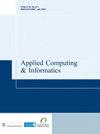Autonomous cycles of data analysis tasks for innovation processes in MSMEs
IF 4.9
Q1 COMPUTER SCIENCE, INFORMATION SYSTEMS
引用次数: 1
Abstract
PurposeThe authors propose the concept of “Autonomic Cycle for innovation processes,” which defines a set of tasks of data analysis, whose objective is to improve the innovation process in micro-, small and medium-sized enterprises (MSMEs).Design/methodology/approachThe authors design autonomic cycles where each data analysis task interacts with each other and has different roles: some of them must observe the innovation process, others must analyze and interpret what happens in it, and finally, others make decisions in order to improve the innovation process.FindingsIn this article, the authors identify three innovation sub-processes which can be applied to autonomic cycles, which allow interoperating the actors of innovation processes (data, people, things and services). These autonomic cycles define an innovation problem, specify innovation requirements, and finally, evaluate the results of the innovation process, respectively. Finally, the authors instance/apply the autonomic cycle of data analysis tasks to determine the innovation problem in the textile industry.Research limitations/implicationsIt is necessary to implement all autonomous cycles of data analysis tasks (ACODATs) in a real scenario to verify their functionalities. Also, it is important to determine the most important knowledge models required in the ACODAT for the definition of the innovation problem. Once determined this, it is necessary to define the relevant everything mining techniques required for their implementations, such as service and process mining tasks.Practical implicationsACODAT for the definition of the innovation problem is essential in a process innovation because it allows the organization to identify opportunities for improvement.Originality/valueThe main contributions of this work are: For an innovation process is specified its ACODATs in order to manage it. A multidimensional data model for the management of an innovation process is defined, which stores the required information of the organization and of the context. The ACODAT for the definition of the innovation problem is detailed and instanced in the textile industry. The Artificial Intelligence (AI) techniques required for the ACODAT for the innovation problem definition are specified, in order to obtain the knowledge models (prediction and diagnosis) for the management of the innovation process for MSMEs of the textile industry.中小微企业创新过程数据分析任务的自主循环
目的作者提出了“创新过程的自主循环”的概念,该概念定义了一组数据分析任务,其目标是改善中小微企业的创新过程。设计/方法论/方法作者设计了自主循环,每个数据分析任务相互作用,并扮演不同的角色:他们中的一些人必须观察创新过程,另一些人必须分析和解释其中发生的事情,最后,其他人做出决策,以改进创新过程。发现在本文中,作者确定了三个可应用于自主循环的创新子流程,这些流程允许创新流程的参与者(数据、人员、事物和服务)进行互操作。这些自主循环定义了一个创新问题,规定了创新要求,最后分别评估了创新过程的结果。最后,作者举例/应用数据分析任务的自主循环来确定纺织行业的创新问题。研究局限性/含义有必要在真实场景中实现数据分析任务(ACODAT)的所有自主循环,以验证其功能。此外,确定ACODAT中定义创新问题所需的最重要的知识模型也很重要。一旦确定了这一点,就有必要定义其实现所需的相关的一切挖掘技术,例如服务和流程挖掘任务。创新问题定义的实际含义ACODAT在流程创新中至关重要,因为它允许组织识别改进的机会。独创性/价值这项工作的主要贡献是:为了管理创新过程,指定了创新过程的ACODAT。定义了用于管理创新过程的多维数据模型,该模型存储了组织和上下文所需的信息。ACODAT对创新问题的定义进行了详细的阐述,并在纺织行业中进行了实例说明。指定了ACODAT定义创新问题所需的人工智能(AI)技术,以获得纺织行业中小微企业创新过程管理的知识模型(预测和诊断)。
本文章由计算机程序翻译,如有差异,请以英文原文为准。
求助全文
约1分钟内获得全文
求助全文
来源期刊

Applied Computing and Informatics
Computer Science-Information Systems
CiteScore
12.20
自引率
0.00%
发文量
0
审稿时长
39 weeks
期刊介绍:
Applied Computing and Informatics aims to be timely in disseminating leading-edge knowledge to researchers, practitioners and academics whose interest is in the latest developments in applied computing and information systems concepts, strategies, practices, tools and technologies. In particular, the journal encourages research studies that have significant contributions to make to the continuous development and improvement of IT practices in the Kingdom of Saudi Arabia and other countries. By doing so, the journal attempts to bridge the gap between the academic and industrial community, and therefore, welcomes theoretically grounded, methodologically sound research studies that address various IT-related problems and innovations of an applied nature. The journal will serve as a forum for practitioners, researchers, managers and IT policy makers to share their knowledge and experience in the design, development, implementation, management and evaluation of various IT applications. Contributions may deal with, but are not limited to: • Internet and E-Commerce Architecture, Infrastructure, Models, Deployment Strategies and Methodologies. • E-Business and E-Government Adoption. • Mobile Commerce and their Applications. • Applied Telecommunication Networks. • Software Engineering Approaches, Methodologies, Techniques, and Tools. • Applied Data Mining and Warehousing. • Information Strategic Planning and Recourse Management. • Applied Wireless Computing. • Enterprise Resource Planning Systems. • IT Education. • Societal, Cultural, and Ethical Issues of IT. • Policy, Legal and Global Issues of IT. • Enterprise Database Technology.
 求助内容:
求助内容: 应助结果提醒方式:
应助结果提醒方式:


